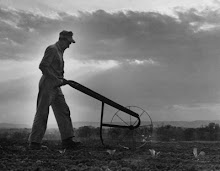I remember, at ten years old, sitting on a little stool in my family’s suburban-home backyard garden, during summer vacation, between rows of carrots and beets, in the hot sun, picking weeds. The weeds were a solid mass of robust greenery, taller than the puny, sun-starved vegetables they engulfed. I pulled those weeds and left them in great piles behind me as I slowly made my way down the rows. It was laborious, boring work that, before long, left me feeling like a just-picked weed myself, wilting in the noonday heat.
Trying to rescue a vegetable garden full of well-established and overgrown weeds is not one of my favorite childhood memories. Not at all. With such trauma in my background, it’s a wonder that I’ve grown up to be an avid vegetable gardener.
I can assure you, though, that I certainly would never have become an avid gardener if I hadn’t learned the simple “secret” to weed control that my city-born father didn’t know and therefore never taught me.
I learned this secret from other, more knowledgeable and experienced gardeners—people who had beautiful, weed-free, and productive gardens. These were people who loved to garden because, in part, they knew the secret I’m about to tell you.
This secret reduces weed control in a garden to a minor and—Believe it or Not—pleasant routine.
This secret is not some newfangled idea. It is as old as gardening and weeds. But so many people in our modern world are ignorant about the old ways of providing for themselves, apart from the provision of the Industrial Providers, that this technique is no longer widely known. And now, as a result of the current economic crisis, many people are, for the first time in their life, planting seeds and hoping for a bountiful harvest. For many, their dreams will be dashed because they do not know the successful gardening ‘secret” that I am about to share with you....
Here is the secret:
The way to easily keeps weeds out of your garden is to cultivate the soil
This is counterintuitive. Why would anyone want to cultivate (hoe) the soil when there are no weeds? Well, because the weeds are there—you just don’t see them yet. Millions of tiny weed seeds throughout the soil are germinating just under the surface, out of sight. They are sprouting and sending their fragile, white, threadlike roots down into the earth before you see any evidence of them above the ground. Each of those fledgling weed seeds has the potential to grow into a moisture and nutrient-robbing giant. The bigger they get, the more extensive the root system grows, and the harder those weeds will be to eradicate.
But all those little filaments, yearning to stake a claim to your garden, can be stopped by merely sliding the blade of a hoe through the soil about an inch below the surface. Such light cultivation is extremely easy to do—when the weeds are very young.
Five or six days after planting your garden seeds, before you see the weeds, you should perform a shallow cultivation between the rows. Then do it again no more than a week later. And again a week later.
A wheel hoe (like the Planet Whizbang) is, of course, the easiest and fastest way to cultivate between rows or down walkways between garden beds. For cultivating in the beds where plantings are closer together, a hand hoe is the tool to use. For cultivating the soil up close to your vegetables, a kitchen fork with a careful touch will do the job quite well.
There are numerous hand hoes on the market. I own several but I’m partial to two of them for shallow cultivation. This Amish-Made Hoe From Lehmans is one of my favorites, and This Collinear Hoe From Johnny’s Seeds is a great shallow-cultivation hoe.
Frequent, shallow cultivation with a hoe will not destroy every single weed, but it will get most of them. You will still need to bend over and pull an occasional weed that grows up close to your plantings. But that is no big deal.
As the growing season progresses, and the small weed seeds near the surface of the soil sprout and are hoed to death, less frequent cultivation will be needed. And as the garden plants grow larger, their foliage will provide a “shade mulch” that helps to discourage small seedlings from developing. In other words, weed control gets easier as the season progresses. But you have to get off to the right start and be diligent about your cultivating.
Now you know the “secret” to successful weed control in your garden.






